A Geoweb-Based Tagging System for Borderlands Data Acquisition
Abstract
:1. Introduction
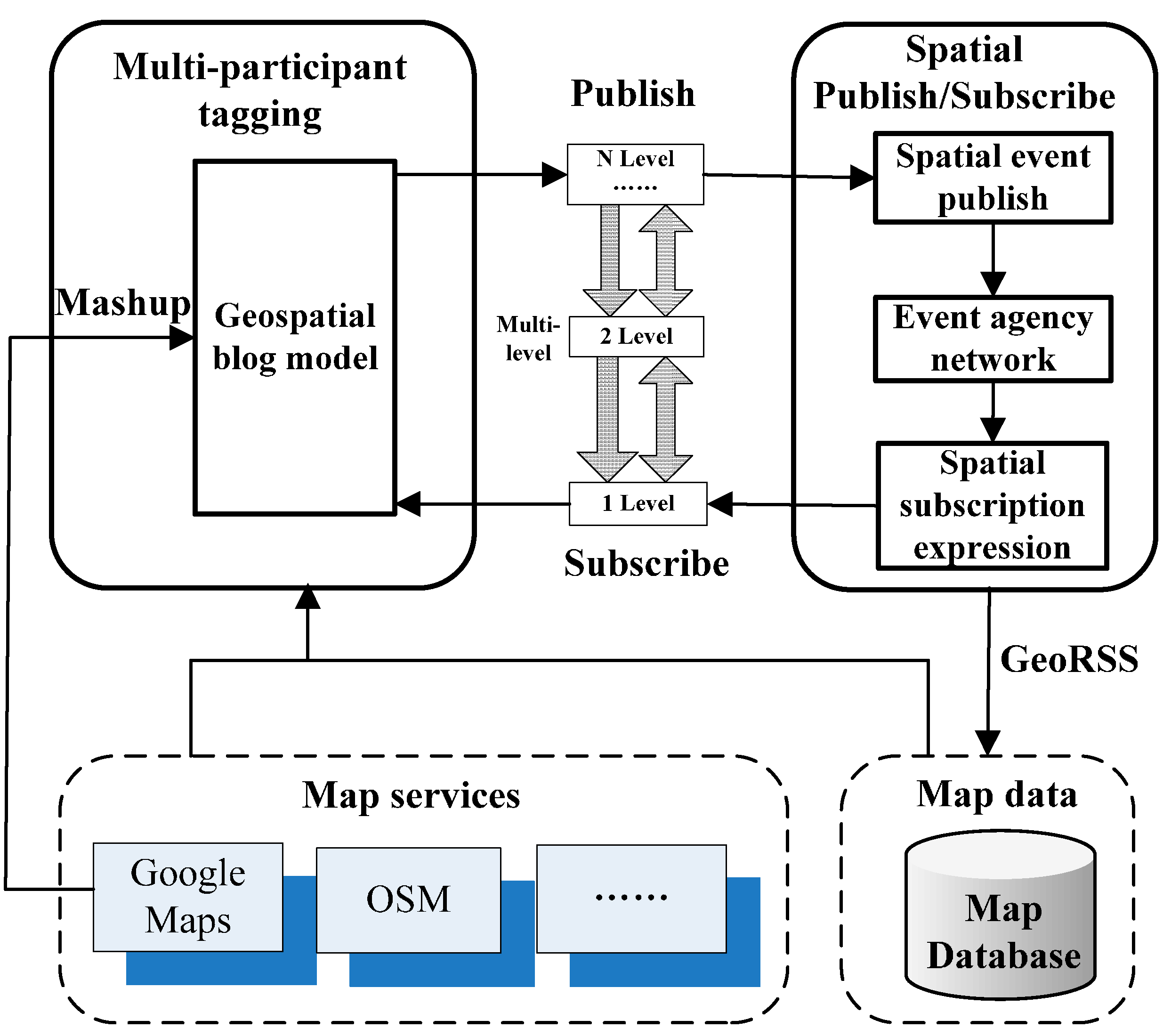
2. Related Works
2.1. Borderland Information Ascquisition
2.2. Geoweb Technologies and Application
2.3. Online Tagging System
3. GeoBlog Model and Its Implementation
3.1. GeoBlog Model
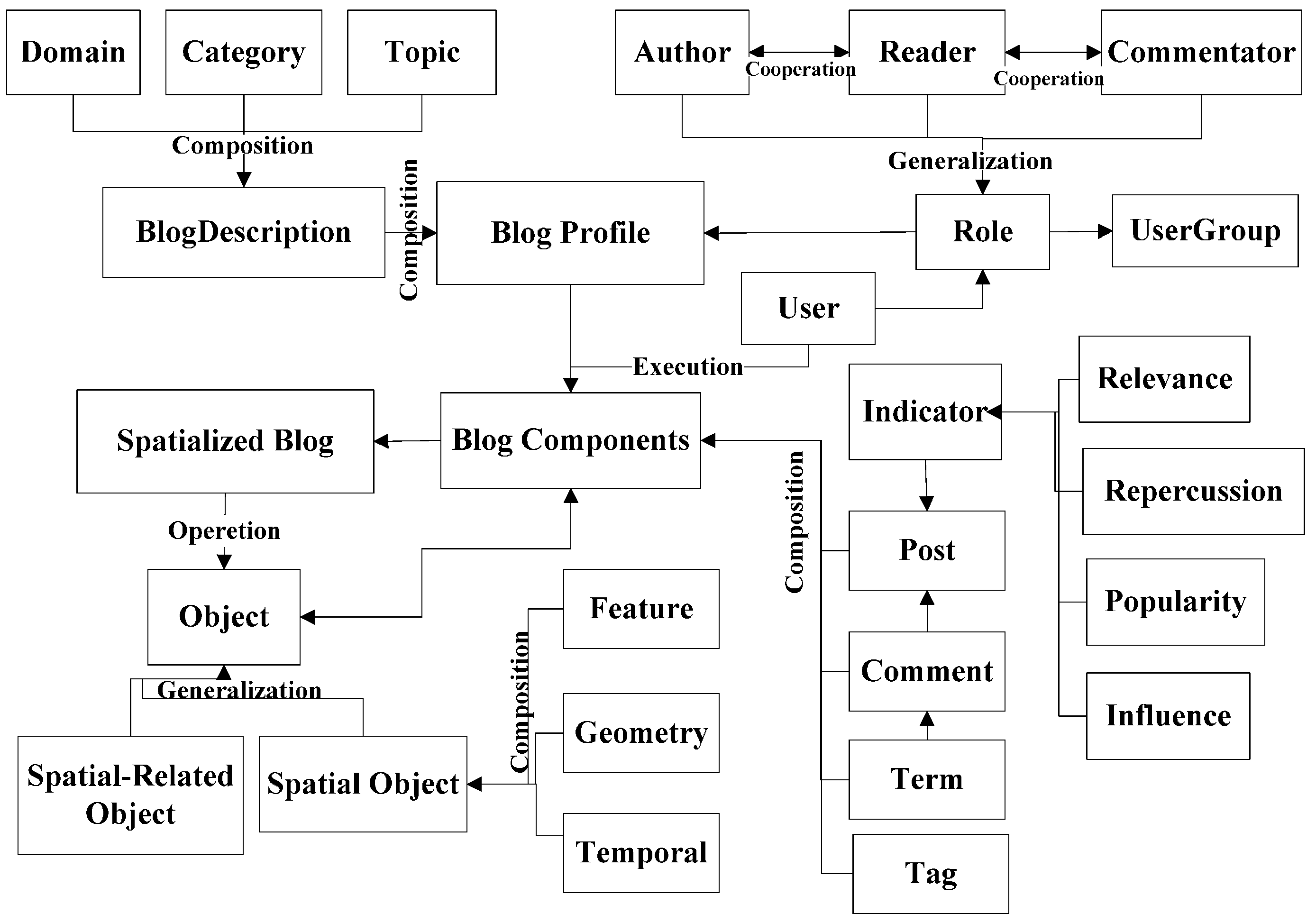
3.2. GeoBlog Mashup with OpenStreetMap
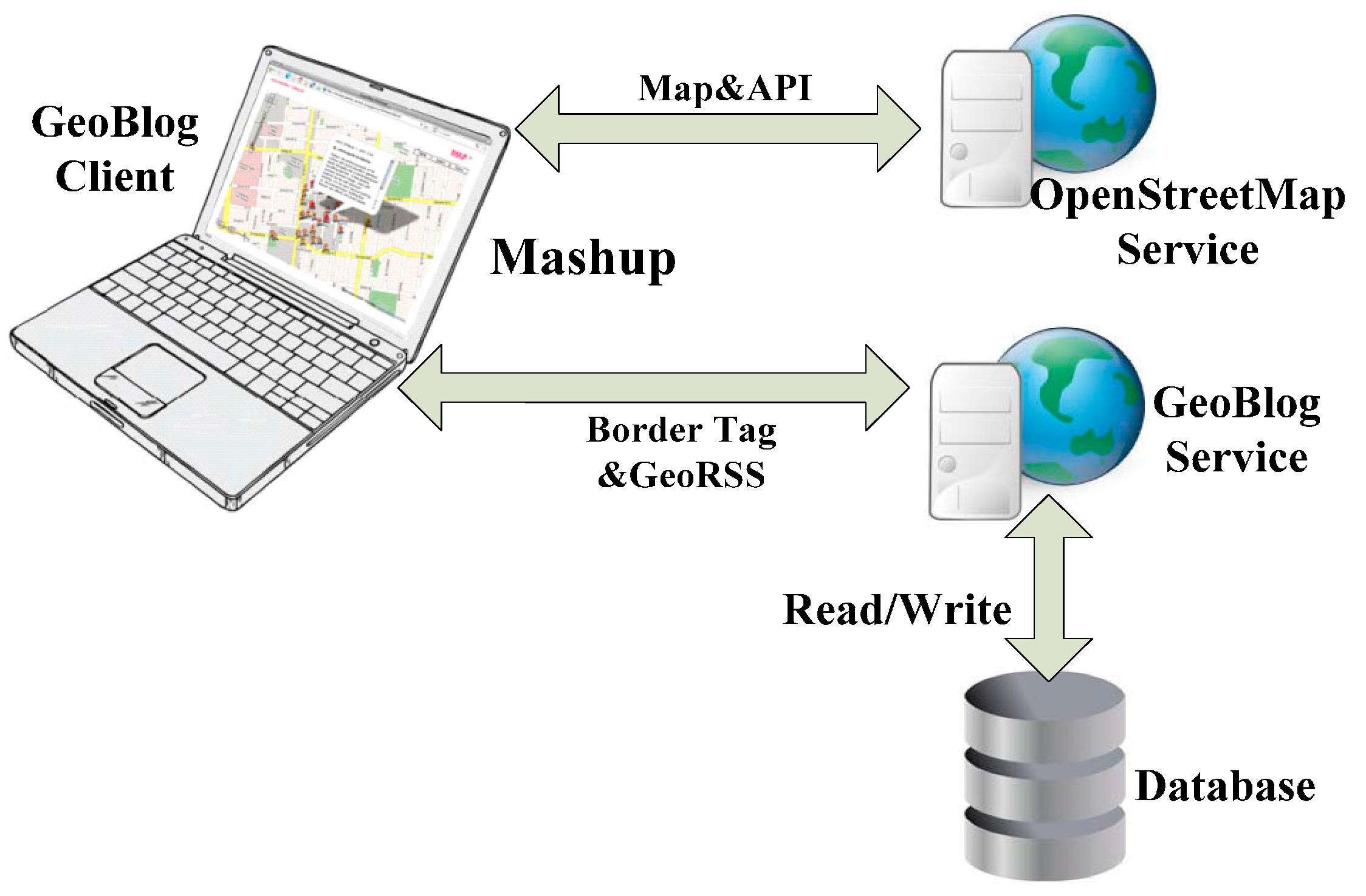
4. Spatial Publish/Subscribe Model
4.1. Spatial Event Model
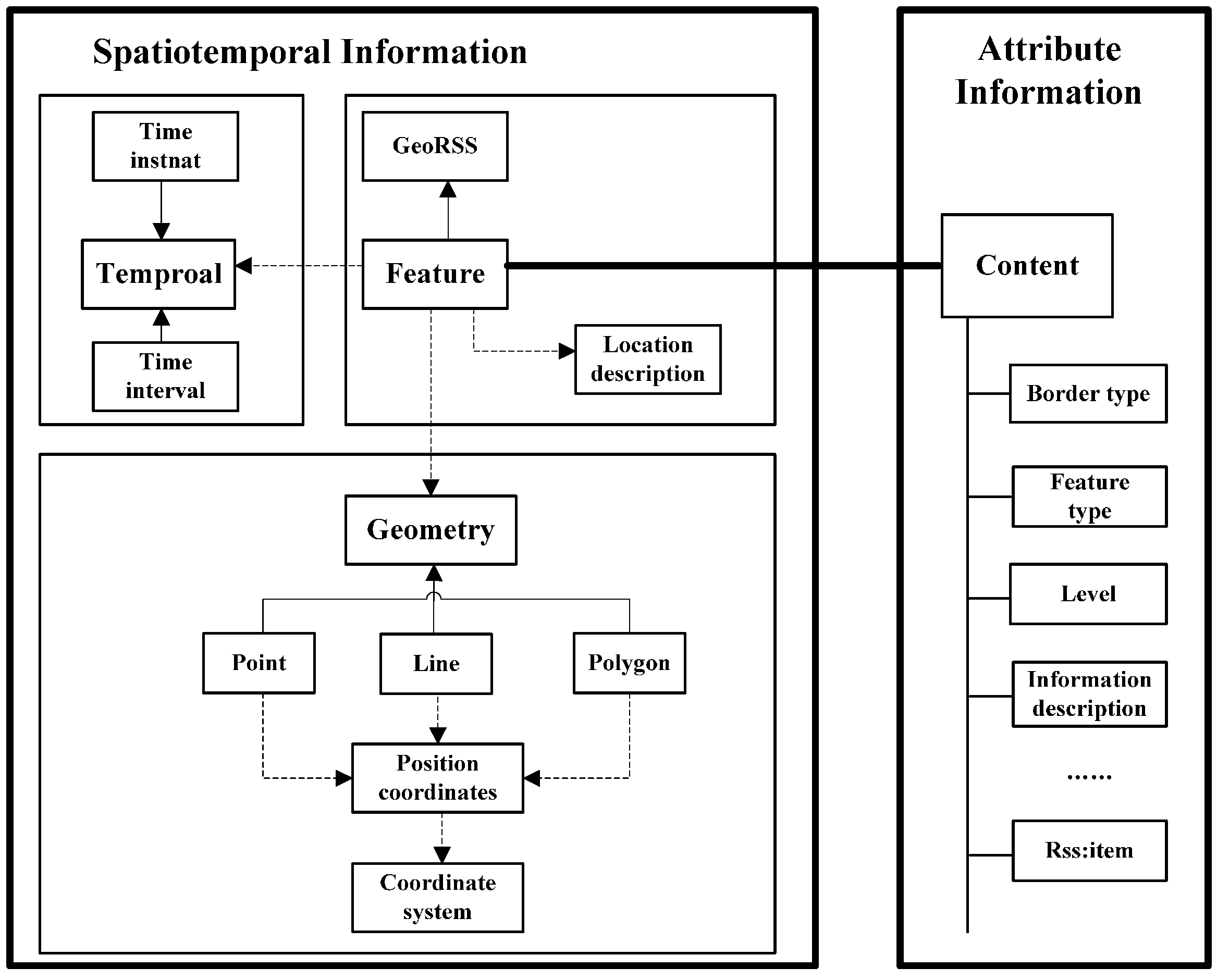
4.2. Spatial Subscription Model
4.3. Event Agency Network
- (1)
- ;
- (2)
- Forward(Bi, ej).
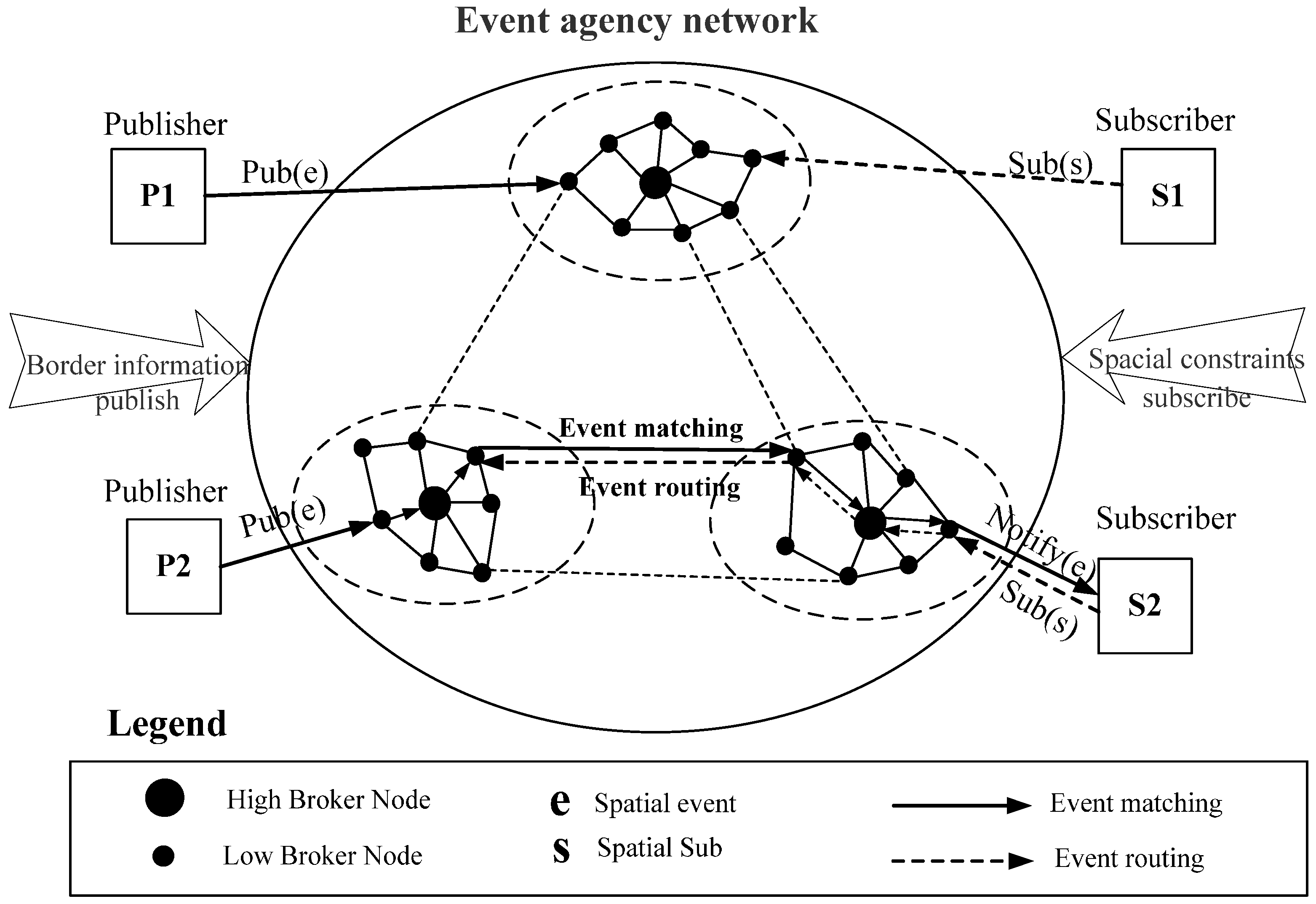
5. Prototyping and Implementation
5.1. System Implementation Architecture
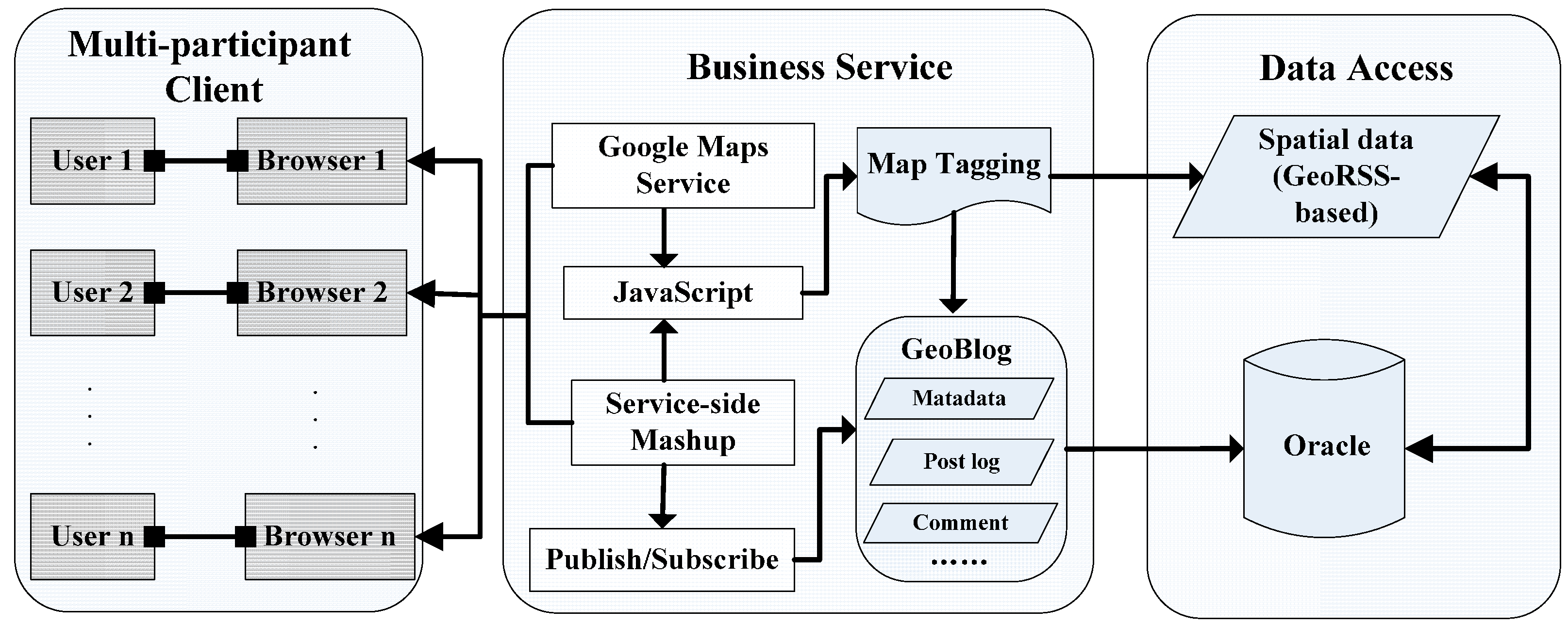
5.2. Tagging System Database Structure
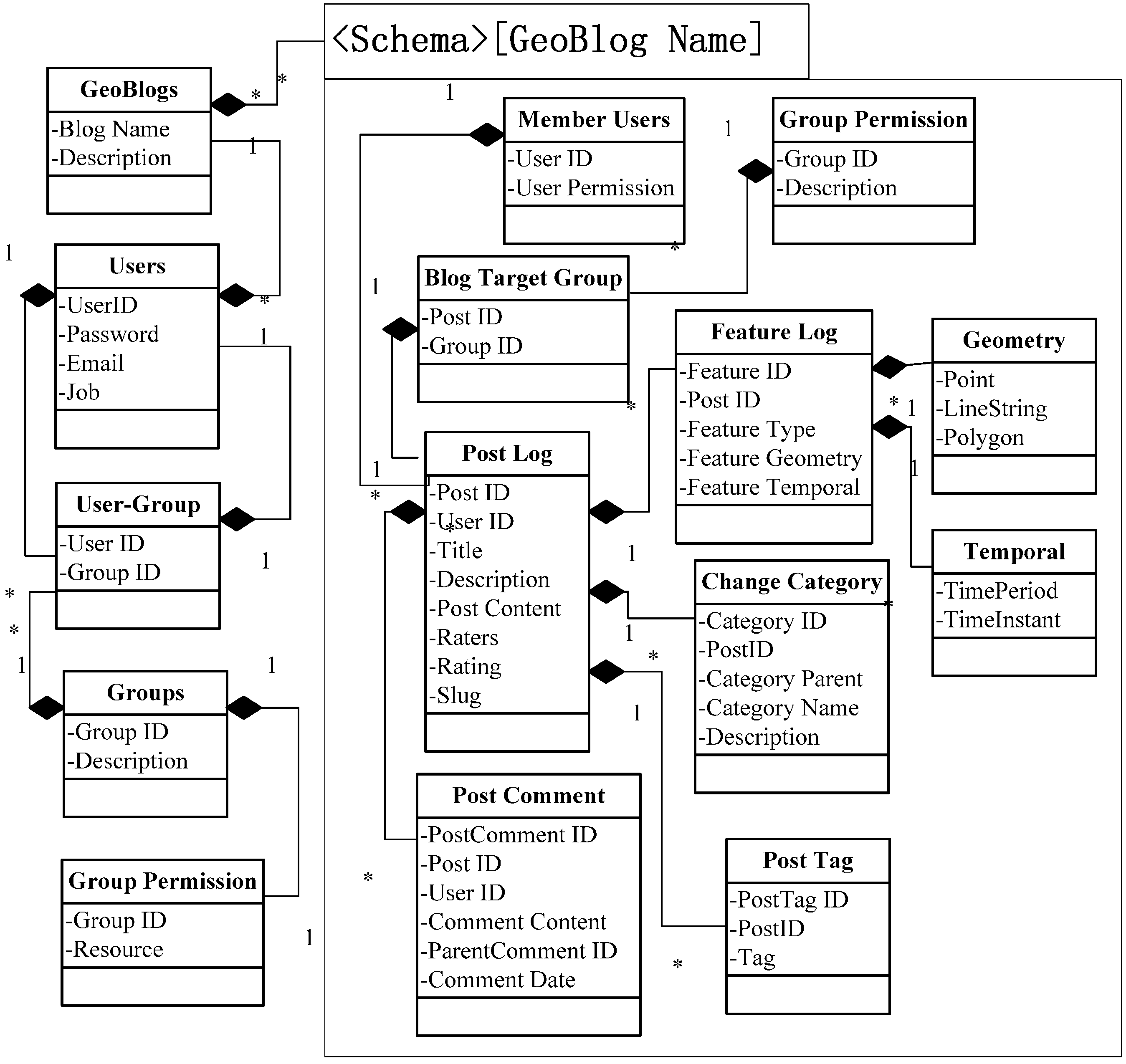
5.3. Transfer of Messages in Tagging System
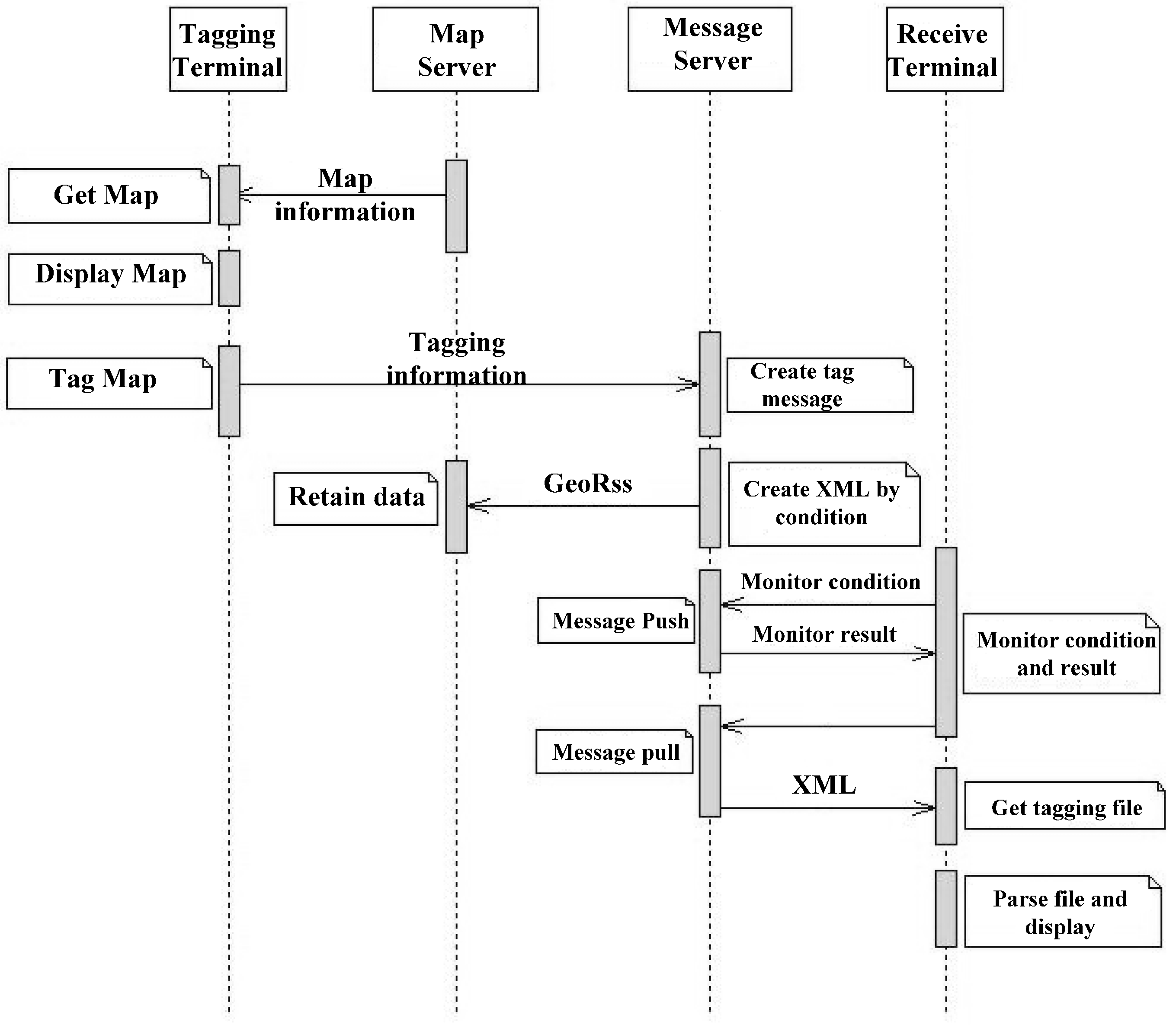
5.4. Applications

6. Conclusions
Acknowledgments
Author Contributions
Conflicts of Interest
References
- Chen, J.; Li, R.; Dong, W.H.; Ge, Y.; Liao, H.; Cheng, Y. GIS-based borderlands modeling and understanding: A perspective. ISPRS Int. J. Geo-Inf. 2015, 4, 661–676. [Google Scholar] [CrossRef]
- Bie, Q.; Zhou, S.; Li, C. The impact of Border policy effect on cross-border ethnic areas. Int. Arch. Photogramm. Remote Sens. Spat. Inf. Sci. 2013, XL-4/W3, 35–40. [Google Scholar] [CrossRef]
- Zhou, X.G.; Jiang, Y.; Zhou, K.; Zeng, L. A dynamic integration method for borderland database using OSM data. Int. Arch. Photogramm. Remote Sens. Spat. Inf. Sci. 2013, XL-4/W3, 141–147. [Google Scholar] [CrossRef]
- Sui, D.; Elwood, S.; Goodchild, M.F. Crowdsourcing geographic knowledge: Volunteered geographic information (VGI) in theory and practice. Int. J. Geogr. Inf. Sci. 2014, 28, 847–849. [Google Scholar]
- Clark, A. Where 2.0 Australia’s environment? Crowdsourcing, volunteered geographic information, and citizens acting as sensors for environmental sustainability. ISPRS Int. J. Geo-Inf. 2014, 3, 1058–1076. [Google Scholar] [CrossRef]
- Fast, V.; Rinner, C. A systems perspective on Volunteered Geographic Information. ISPRS Int. J. Geo-Inf. 2014, 3, 1278–1292. [Google Scholar] [CrossRef]
- Kumar, C.; Heuten, W.; Boll, S. Visual overlay on OpenStreetMap data to support spatial exploration of urban environments. ISPRS Int. J. Geo-Inf. 2015, 4, 87–104. [Google Scholar] [CrossRef]
- Hall, G.B.; Chipeniuk, R.; Feick, R.D.; Leahy, M.G.; Deparday, V. Community-based production of geographic information using open source software and Web 2.0. Int. J. Geogr. Inf. Sci. 2010, 24, 761–781. [Google Scholar] [CrossRef]
- Rinner, C.; Keßler, C.; Andrulis, S. The use of web 2.0 concepts to support deliberation in spatial decision-making. Comput. Environ. Urban Syst. 2008, 32, 386–395. [Google Scholar] [CrossRef]
- Gao, Y.; Gao, S.; Li, R.-Q.; Liu, Y. A semantic geographical knowledge wiki system mashed up with google maps. Sci. China Technol. Sci. 2010, 53, 52–60. [Google Scholar] [CrossRef]
- Elwood, S. Grassroots groups as stakeholders in spatial data infrastructures: Challenges and opportunities for local data development and sharing. Int. J. Geogr. Inf. Sci. 2008, 22, 71–90. [Google Scholar] [CrossRef]
- Wang, J.; Cheng, Y.; Mo, H. The spatio-temporal distribution and development modes of border ports in China. Sustainability 2014, 6, 7089–7106. [Google Scholar] [CrossRef]
- Chen, J.; Hua, Y.-X.; Wang, F.-L.; Chen, H.-B.; Liu, W.-Z.; Zhou, Z.-W.; Zhang, Y. Research and establishment of China’s digital boundary. Acta Geideica Cartogr. Sin. 2012, 41, 791–796. [Google Scholar]
- Chi, H.; Sun, G.Q.; Huang, J.L.; Guo, Z.; Ni, W.; Fu, A. National forest aboveground biomass mapping from ICESat/GLAS data and MODIS imagery in China. Remote Sens. 2015, 7, 5534–5564. [Google Scholar] [CrossRef]
- Sun, M.; Dong, N.; Zheng, H.; Jiang, C.; Ren, X. A method of 3D-GIS application aided with stereo panorama technology. Int. Arch. Photogramm. Remote Sens. Spat. Inf. Sci. 2013, XL-4/W3, 123–130. [Google Scholar] [CrossRef]
- Hou, D.Y.; Wu, H.; Chen, J.; Li, R. A focused crawler for borderlands situation information with geographical properties of place names. Sustainability 2014, 6, 6529–6552. [Google Scholar] [CrossRef]
- Hu, H.; Ge, Y.; Hou, D. Using web crawler technology for geo-events analysis: A case study of the Huangyan Island incident. Sustainability 2014, 6, 1896–1912. [Google Scholar] [CrossRef]
- Goodchild, M.F. Citizens as sensors: The world of volunteered geography. GeoJounal 2007, 69, 211–221. [Google Scholar] [CrossRef]
- Johnson, P.A.; Sieber, R.E. Motivations driving government adoption of the Geoweb. GeoJournal 2012, 77, 667–680. [Google Scholar] [CrossRef]
- Deufemia, V.; Mascardi, V.; Paolino, L.; Polese, G.; Lumley, H.D. A volunteered geographic information system for collecting and rating petroglyph data. J. Vis. Lang. Comput. 2014, 25, 963–972. [Google Scholar] [CrossRef]
- Shih, F.; Seneviratne, O.; Miao, D.; Licardi, I.; Kagal, L.; Patton, E.W.; Castillo, C.; Meier, P. Democratizing mobile app development for disaster management. In Proceedings of the Workshop on AI Problems and Approaches for Intelligent Environments and Workshop on Semantic Cities, Beijing, China, 3–9 August 2013.
- Heinzelman, J.; Waters, C. Crowdsourcing Crisis Information in Disaster Affected Haiti; Special Report No. 252; United States Institute of Peace: Washington, DC, USA, 2010. [Google Scholar]
- Haklay, M.; Weber, P. OpenStreetMap: User-generated street maps. IEEE Pervasive Comput. 2008, 7, 12–18. [Google Scholar] [CrossRef]
- Fan, H.Q.; Zipf, A.; Fu, Q.; Neis, P. Quality assessment for building footprints data on OpenStreetMap. Int. J. Geogr. Inf. Sci. 2014, 28, 700–719. [Google Scholar] [CrossRef]
- Xing, H.F. Models of spatial marking and reporting for geographic updating. Acta Geideica Cartogr. Sin. 2014, 43, 880–881. [Google Scholar]
- Ballatore, A.; David, C.; Michela, B. Computing the semantic similarity of geographic terms using volunteered lexical definitions. Int. J. Geogr. Inf. Sci. 2013, 27, 2099–2118. [Google Scholar] [CrossRef]
- Quesnot, T.; Roche, S. Measure of landmark semantic salience through geosocial data streams. ISPRS Int. J. Geo-Inf. 2014, 4, 1–31. [Google Scholar]
- Richter, K.F.; Winter, S. Harvesting user-generated content for semantic spatial information: The case of landmarks in OpenStreetMap. In Proceedings of the Surveying & Spatial Sciences Biennial Conference, Wellington, New Zealand, 21–25 November 2011; pp. 75–86.
- Imran, M.; Elbassuoni, S.; Castillo, C.; Diaz, F.; Meier, P. Practical extraction of disaster-relevant information from social media. In Proceedings of the 22nd International Conference on World Wide Web companion, Florence, Italy, 18 May 2013; pp. 1021–1024.
- Delgado, F.; Martínez-González, M.M.; Finat, J. An evaluation of ontology matching techniques on geospatial ontologies. Int. J. Geogr. Inf. Sci. 2013, 27, 2279–2301. [Google Scholar] [CrossRef]
- Egenhofer, M.J. Toward the semantic geospatial web. In Proceedings of the 10th ACM International Symposium on Advances in Geographic Information Systems, McLean, VA, USA, 8–9 November 2002; pp. 1–4.
- Campos, A.; Dividino, R. Blog Ontology (BloOn) & Blog Visualization System (BloViS). In Proceedings of the IEEE First International Workshop on Ontologies in Interactive Systems, Liverpool, UK, 1 September 2008; pp. 83–88.
- Li, S.; Gong, J. Mashup: A new way of providing web mapping/GIS services. In Proceedings of ISPRS 2008 Congress Beijing, Beijing, China, 3–11 July 2008; pp. 639–649.
- Ramsey, P. Mashing up the enterprise. Available online: http://www.geospatialsolutions.com/geospatialsolutions/author/authorDetail.jsp?id=34062 (accessed on 10 March 2008).
- Pietroniro, E.; Fichter, D. Map mashups and the rise of amateur cartographers and mapmakers. ACMLA Bull. 2007, 127, 26–30. [Google Scholar]
- Eugster, P.; Felber, P.; Guerraoui, R.; Kermarrec, A.-M. The many faces of publish/subscribe. ACM Comput. Surv. 2003, 35, 114–131. [Google Scholar] [CrossRef]
- Demers, A.; Gehrke, J.; Hong, M.; Riedewald, M.; White, W. Towards expressive publish/subscribe systems. In Advances in Database Technology—EDBT; Ioannidis, Y., Scholl, M.H., Schmidt, J.W., Matthes, F., Hatzopoulos, M., Boehm, K., Kemper, A., Grust, T., Boehm, C., Eds.; Springer: Heidelberg, Germany, 2006; pp. 627–644. [Google Scholar]
- Paikan, A.; Domenichelli, D.; Natale, L. Communication channel prioritization in a publish-subscribe architecture. Available online: http://arxiv.org/abs/1504.02128 (accessed on 19 August 2015).
- Long, Y.H.; Wang, K.; Tang, Z.Q. Primary exploration of the approach of geographic data encoding GeoRSS. Sci. Surv. Mapp. 2010, 35, 225–224. [Google Scholar]
- Konstantinidis, A.; Carzaniga, A.; Wolf, A. A content-based publish/subscribe matching algorithm for 2D spatial objects. In Proceedings of the 12th International Middleware Conference, Lisboa, Portugal, 12–16 December 2011; pp. 208–227.
- Chris, W.; Richard, F. A reusable ontology for fluents in OWL. In Proceedings of the Fourth International Conference on Formal Ontology in Information Systems, Baltimore, MD, USA, 9–11 November 2006; pp. 226–236.
- Hu, S.Y.; Wu, C.; Buyukkaya, E.; Chien, C.H.; Lin, T.H.; Abdallah, M. A spatial publish subscribe overlay for massively multiuser virtual environments. In Proceedings of the IEEE International Conference on Electronics & Information Engineering, Kyoto, Japan, 1–3 August 2010; pp. 314–318.
- Pallickara, S.; Pierce, M.; Gadgil, H.; Fox, G.; Yan, Y.; Huang, Y. A framework for secure end-to-end delivery of messages in publish/subscribe systems. In Proceedings of the 7th IEEE/ACM International Conference on Grid Computing, Barcelona, Spain, 28–29 September 2006; pp. 215–222.
- Dodge, M.; Kitchin, R. Crowdsourced cartography: Mapping experience and knowledge. Environ. Plan. A 2013, 45, 19–36. [Google Scholar] [CrossRef]
- Harvey, F. To volunteer or to contribute locational information? Towards truth in labeling for crowdsourced geographic information. In Crowdsourcing Geographic Knowledge; Sui, D., Elwood, S., Goodchild, M., Eds.; Springer: Heidelberg, Germany, 2013; pp. 31–42. [Google Scholar]
© 2015 by the authors; licensee MDPI, Basel, Switzerland. This article is an open access article distributed under the terms and conditions of the Creative Commons Attribution license (http://creativecommons.org/licenses/by/4.0/).
Share and Cite
Xing, H.; Chen, J.; Zhou, X. A Geoweb-Based Tagging System for Borderlands Data Acquisition. ISPRS Int. J. Geo-Inf. 2015, 4, 1530-1548. https://doi.org/10.3390/ijgi4031530
Xing H, Chen J, Zhou X. A Geoweb-Based Tagging System for Borderlands Data Acquisition. ISPRS International Journal of Geo-Information. 2015; 4(3):1530-1548. https://doi.org/10.3390/ijgi4031530
Chicago/Turabian StyleXing, Hanfa, Jun Chen, and Xiaoguang Zhou. 2015. "A Geoweb-Based Tagging System for Borderlands Data Acquisition" ISPRS International Journal of Geo-Information 4, no. 3: 1530-1548. https://doi.org/10.3390/ijgi4031530
APA StyleXing, H., Chen, J., & Zhou, X. (2015). A Geoweb-Based Tagging System for Borderlands Data Acquisition. ISPRS International Journal of Geo-Information, 4(3), 1530-1548. https://doi.org/10.3390/ijgi4031530






